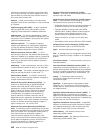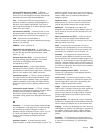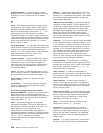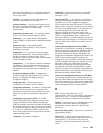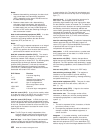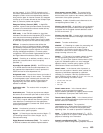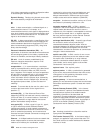
Glossary
This glossary includes terms and definitions from:
v The
American National Standard Dictionary for
Information Systems
, ANSI X3.172-1990,
copyright 1990 by the American National
Standards Institute (ANSI). Copies may be
purchased from the American National
Standards Institute, 11 West 42nd Street, New
York, New York 10036. Definitions are identified
by the symbol (A) after the definition.
v The ANSI/EIA Standard—440-A,
Fiber Optic
Terminology
Copies may be purchased from the
Electronic Industries Association, 2001
Pennsylvania Avenue, N.W., Washington, DC
20006. Definitions are identified by the symbol
(E) after the definition.
v The
Information Technology Vocabulary
developed by Subcommittee 1, Joint Technical
Committee 1, of the International Organization
for Standardization and the International
Electrotechnical Commission (ISO/IEC
JTC1/SC1). Definitions of published parts of this
vocabulary are identified by the symbol (I) after
the definition; definitions taken from draft
international standards, committee drafts, and
working papers being developed by ISO/IEC
JTC1/SC1 are identified by the symbol (T) after
the definition, indicating that final agreement
has not yet been reached among the
participating National Bodies of SC1.
v The
IBM Dictionary of Computing
, New York:
McGraw-Hill, 1994.
v Internet Request for Comments: 1208,
Glossary
of Networking Terms
v Internet Request for Comments: 1392,
Internet
Users’ Glossary
v The
Object-Oriented Interface Design: IBM
Common User Access Guidelines
, Carmel,
Indiana: Que, 1992.
The following cross-references are used in this
glossary:
Contrast with:
This refers to a term that has an opposed
or substantively different meaning.
Synonym for:
This indicates that the term has the same
meaning as a preferred term, which is
defined in its proper place in the glossary.
Synonymous with:
This is a backward reference from a
defined term to all other terms that have
the same meaning.
See: This refers the reader to multiple-word
terms that have the same last word.
See also:
This refers the reader to terms that have a
related, but not synonymous, meaning.
A
AAL. ATM Adaptation Layer, the layer that adapts user
data to/from the ATM network by adding/removing
headers and segmenting/reassembling the data
into/from cells.
AAL-5. ATM Adaptation Layer 5, one of several
standard AALs. AAL-5 was designed for data
communications, and is used by LAN Emulation and
Classical IP.
abstract syntax. A data specification that includes all
distinctions that are needed in data transmissions, but
that omits (abstracts) other details such as those that
depend on specific computer architectures. See also
abstract syntax notation 1 (ASN.1)
and
basic encoding
rules (BER)
.
abstract syntax notation 1 (ASN.1). The Open
Systems Interconnection (OSI) method for abstract
syntax specified in the following standards:
v ITU-T Recommendation X.208 (1988) | ISO/IEC
8824: 1990
v ITU-T Recommendation X.680 (1994) | ISO/IEC
8824-1: 1994
See also
basic encoding rules (BER)
.
ACCESS. In the Simple Network Management
Protocol (SNMP), the clause in a Management
Information Base (MIB) module that defines the
minimum level of support that a managed node provides
for an object.
acknowledgment. (1) The transmission, by a receiver,
of acknowledge characters as an affirmative response
to a sender. (T) (2) An indication that an item sent
was received.
active. (1) Operational. (2) Pertaining to a node or
device that is connected or is available for connection to
another node or device.
active monitor. In a token-ring network, a function
performed at any one time by one ring station that
© Copyright IBM Corp. 1994, 1998 447












